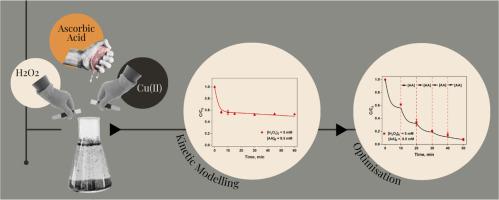利用机械动力学模型优化还原剂介导的铜类芬顿系统中的污染物降解
IF 12.4
1区 环境科学与生态学
Q1 ENGINEERING, ENVIRONMENTAL
引用次数: 0
摘要
建立了Cu(II)/AA(抗坏血酸)和Cu(II)/H2O2/AA体系在不同氯浓度和环中性ph下的机理动力学模型并进行了验证。虽然Cu(II)/AA体系通过类似芬顿的机制生成Cu(III)来降解选定的目标污染物(甲酸盐),但观察到的效率不足以在广泛的氯浓度范围内进行实际水处理。这种限制源于H2O2生成不足,导致Cu(III)浓度低,以及AA及其氧化产物对Cu(III)的清除。相反,在低氯离子浓度下,在Cu(II)/H2O2体系中加入AA可以加速Cu(II)还原为Cu(I),促进铜的氧化还原循环,增加Cu(III)的生成,从而增强降解能力。然而,由于AA及其副产物对Cu(III)的清除作用,降解在10分钟内稳定在约40%。使用开发的模型,优化的试剂剂量策略通过以10分钟的间隔连续添加AA,在1小时内实现了90%以上的甲酸降解。该方法采用无害试剂,在低氯浓度下表现出高效率,为废水处理过程中去除可氧化有机污染物提供了一种很有前途的方法。事实证明,该模型有助于优化试剂用量,提高降解效率,并有可能降低铜基高级氧化工艺的运营成本。本文章由计算机程序翻译,如有差异,请以英文原文为准。

Optimising Pollutant Degradation in Reductant-mediated Copper Fenton-Like Systems Using Mechanistically-based Kinetic Modelling
A mechanistic kinetic model has been developed and validated for Cu(II)/AA (ascorbic acid) and Cu(II)/H2O2/AA systems under varying chloride concentrations and circumneutral pH. While the Cu(II)/AA system degraded the selected target contaminant (formate) via Cu(III) generation through a Fenton-like mechanism, observed efficiencies were inadequate for practical water treatment across a broad range of chloride concentrations. This limitation stemmed from insufficient H2O2 production, leading to low Cu(III) concentrations, and scavenging of Cu(III) by AA and its oxidation products. Conversely, adding AA to the Cu(II)/H2O2 system at low chloride concentrations enhanced degradation by accelerating Cu(II) reduction to Cu(I), promoting copper redox cycling and increasing Cu(III) formation. However, degradation plateaued at approximately 40% within 10 minutes due to Cu(III) scavenging by AA and its byproducts. Using the developed model, optimised reagent dosing strategies achieved over 90% formate degradation within an hour through consecutive AA additions at 10 min intervals. This approach, employing non-hazardous reagents and demonstrating high efficiency at low chloride concentrations, offers a promising approach to removal of oxidisable organic contaminants during wastewater treatment. The model proved instrumental in optimising reagent dosing, enhancing degradation efficiency, and potentially reducing operational costs for scaling up of a copper-based advanced oxidation process.
求助全文
通过发布文献求助,成功后即可免费获取论文全文。
去求助
来源期刊

Water Research
环境科学-工程:环境
CiteScore
20.80
自引率
9.40%
发文量
1307
审稿时长
38 days
期刊介绍:
Water Research, along with its open access companion journal Water Research X, serves as a platform for publishing original research papers covering various aspects of the science and technology related to the anthropogenic water cycle, water quality, and its management worldwide. The audience targeted by the journal comprises biologists, chemical engineers, chemists, civil engineers, environmental engineers, limnologists, and microbiologists. The scope of the journal include:
•Treatment processes for water and wastewaters (municipal, agricultural, industrial, and on-site treatment), including resource recovery and residuals management;
•Urban hydrology including sewer systems, stormwater management, and green infrastructure;
•Drinking water treatment and distribution;
•Potable and non-potable water reuse;
•Sanitation, public health, and risk assessment;
•Anaerobic digestion, solid and hazardous waste management, including source characterization and the effects and control of leachates and gaseous emissions;
•Contaminants (chemical, microbial, anthropogenic particles such as nanoparticles or microplastics) and related water quality sensing, monitoring, fate, and assessment;
•Anthropogenic impacts on inland, tidal, coastal and urban waters, focusing on surface and ground waters, and point and non-point sources of pollution;
•Environmental restoration, linked to surface water, groundwater and groundwater remediation;
•Analysis of the interfaces between sediments and water, and between water and atmosphere, focusing specifically on anthropogenic impacts;
•Mathematical modelling, systems analysis, machine learning, and beneficial use of big data related to the anthropogenic water cycle;
•Socio-economic, policy, and regulations studies.
 求助内容:
求助内容: 应助结果提醒方式:
应助结果提醒方式:


